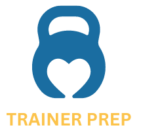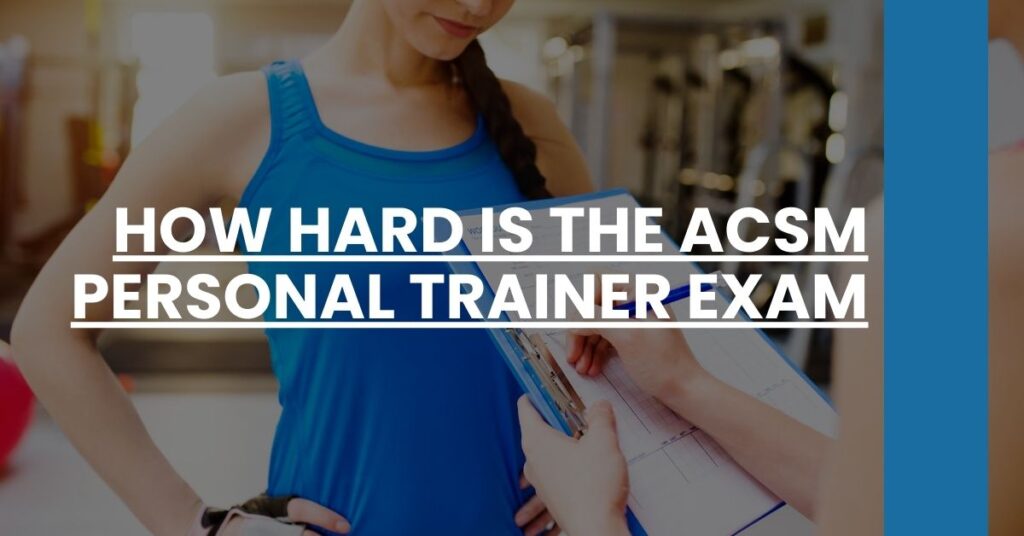The ACSM Personal Trainer Exam is known for its rigor and in-depth coverage of exercise science. Many candidates find it challenging due to its broad range of topics and demanding questions. However, with focused preparation, utilizing recommended resources, and consistent study habits, you can ace it. In this article, you’ll discover key topics, expert opinions, and effective strategies to conquer the exam.
What is the ACSM Personal Trainer Exam?
The ACSM Personal Trainer Exam is a crucial certification for those looking to establish themselves as experts in the fitness industry. The American College of Sports Medicine (ACSM) offers this certification to assess a wide range of skills and knowledge required to be an effective personal trainer. This exam helps ensure that trainers are proficient in creating safe and effective exercise programs for diverse populations.
To qualify for the ACSM Personal Trainer Exam, you need to meet specific criteria. You must be at least 18 years old with a high school diploma or equivalent. Additionally, candidates must hold a current CPR/AED certification. The certification exam serves as an essential benchmark for evaluating your readiness to work in a professional fitness setting.
Structure of the Exam
Understanding the structure of the ACSM Personal Trainer Exam can significantly reduce your anxiety and help you prepare more efficiently.
Format and Duration
The exam consists of 150 multiple-choice questions, out of which 120 are scored. The remaining 30 are experimental questions used to gather statistical information for future tests. You have 165 minutes to complete the exam, which equates to just over a minute per question.
Types of Questions
- Multiple-Choice Questions: Most questions are straightforward, with one correct answer out of four options. These assess fundamental knowledge in personal training.
- Scenario-Based Questions: These questions present real-life client scenarios requiring you to choose the best course of action. This tests your practical application of theoretical knowledge.
Areas Covered
The questions can be broken down into specific weightings, allowing you to focus your study efforts strategically:
- Initial Client Consultation and Assessment (25%)
- Exercise Programming and Implementation (45%)
- Exercise Leadership and Client Education (20%)
- Legal and Professional Responsibilities (10%)
Key Topics Covered
To ace the ACSM Personal Trainer Exam, you need a thorough grasp of various subjects. These topics span several domains that are essential for effective personal training.
Exercise Science Fundamentals
- Anatomy and Physiology: You’ll need a deep understanding of muscle actions, cardiovascular and respiratory systems, and neuromuscular functions.
- Kinesiology: This involves knowledge of movement patterns, including joint mechanics and muscle group synergy.
- Exercise Physiology: Understanding how the body responds to physical activity, including acute and chronic adaptations, is crucial.
Client Consultation and Assessment
- Risk Stratification: Learn to assess risk factors related to cardiovascular disease.
- Fitness Testing: Understand protocols for testing cardiovascular endurance, muscular strength, and flexibility.
- Goal Setting: Develop skills to set realistic and achievable fitness goals for clients.
Program Planning and Implementation
- Exercise Prescription: Create individualized programs based on client goals, fitness levels, and health conditions.
- Periodization: Understand theories of periodization and how to apply them to program design.
- Progression and Modification: Learn how to progress exercises and modify programs based on client feedback and performance.
Legal and Professional Responsibilities
- Ethics and Professional Conduct: Familiarize yourself with the ACSM Code of Ethics.
- Legal Liability: Understand the legal implications of your actions as a trainer and how to safeguard against potential litigation.
Difficulty Level: Expert Opinions
Determining how hard the ACSM Personal Trainer Exam is can vary from person to person. However, insights from experts provide a well-rounded perspective.
Comparison with Other Certifications
Fitness professionals often recognize the ACSM exam as one of the more challenging certification tests. Compared to exams from ACE or NASM, the ACSM exam requires a deeper understanding of exercise science fundamentals. This rigor makes it highly regarded but also more demanding.
Scientific Rigidity
Experts like Dr. Anthony Abbott consider the ACSM certification to be the “Gold Standard”. This is primarily because the ACSM places a strong emphasis on scientifically validated information. As a result, the exam scrutinizes your knowledge to a greater depth, which sets it apart from other certifications.
Range of Topics
The comprehensive nature of the exam is another reason for its difficulty. With topics ranging from kinesiology to client consultation strategies, the breadth of knowledge required is extensive. This demands a disciplined study approach and an ability to integrate various domains of knowledge.
Candidate Experiences
Many experts note that candidates often underestimate the exam’s complexity. The ACSM Personal Trainer Exam doesn’t just assess theoretical understanding but also practical application. You need to be prepared for scenario-based questions that test your ability to think critically and make sound judgments.
Candidate Experiences and Feedback
Hearing from those who have walked the path before you can provide valuable insights into the real-world difficulty of the ACSM Personal Trainer Exam.
Success Rates
While exact pass rates are not publicly disclosed, anecdotal evidence suggests that many candidates do not pass on their first attempt. This underscores the importance of thorough preparation. Candidates who invest significant time in studying often fare better.
Common Challenges
- Depth of Scientific Questions: Many candidates find the depth of questions on topics like biomechanics and exercise physiology particularly challenging.
- Scenario-Based Questions: These questions are designed to test practical application, which can be a stumbling block for those who are well-versed in theory but lack real-world experience.
- Time Management: With only 165 minutes to tackle 150 questions, efficient time management is essential.
Preparation Tips from Successful Candidates
Successful candidates often share that a multi-faceted approach to studying is most effective. This includes not only reading textbooks but also engaging with practice exams, flashcards, and mobile apps. Many recommend the use of “ACSM’s Resources for the Personal Trainer,” which they find indispensable.
Personal anecdotes reveal that candidates who dedicate consistent study hours each week feel more confident and prepared. Some also suggest engaging in study groups or seeking mentors who have already passed the exam.
For more comprehensive preparation resources and personalized coaching, consider visiting our ACSM CPT Exam Prep Services.
By tapping into these insights and employing effective study strategies, you can significantly improve your chances of passing the ACSM Personal Trainer Exam on your first attempt.
Preparation Tips and Resources
Effectively preparing for the ACSM Personal Trainer Exam requires a strategic approach. Below are actionable tips and high-quality resources that can bolster your study routine.
Effective Study Strategies
Crafting a well-rounded study plan is crucial. Here’s how you can maximize your preparation:
- Consistent Study Schedule: Devote time each week specifically for studying. Aim for 2-3 hour sessions, several times a week. Consistency is key.
- Practice Tests: Utilize practice exams to familiarize yourself with the format and type of questions you’ll face. This will also help identify areas where you need further review.
- Active Learning: Engage in active learning techniques such as making flashcards, taking notes, and teaching back the material to ensure you internalize the concepts.
Recommended Textbooks
Having the right books can make a significant difference. Here are some top choices recommended by successful candidates:
- “ACSM’s Resources for the Personal Trainer” is an essential guide. It covers both the scientific principles and practical applications needed for the exam.
- “Essentials of Exercise Science for Fitness Professionals” provides a solid foundation in exercise science that is pertinent to the exam content.
Online Resources and Workshops
Leveraging additional resources can offer extra support and insights:
- Online Courses: Websites like Coursera and Khan Academy offer courses related to exercise physiology and biomechanics that align with the exam syllabus.
- Workshops and Webinars: Participating in ACSM-certified workshops and webinars can provide hands-on experience and direct interaction with experienced instructors.
Utilizing Flashcards
Creating and using flashcards can help reinforce your memory of key concepts. Flashcard apps like Anki or Quizlet allow for portable study sessions, whether you’re commuting or waiting in line.
Mobile Apps
Several mobile apps are designed to aid in exam preparation:
- Pocket Prep: Offers a wide range of practice questions and customizable quizzes that mimic the exam format.
- Brainscape: Allows you to create your own flashcards or use pre-made sets specifically for the ACSM exam.
Time Investment for Preparation
Understanding the time required for adequate preparation can help you plan better.
Average Study Duration
Most candidates spend between 3 to 6 months preparing for the ACSM Personal Trainer Exam. This time frame allows for a thorough review without overwhelming yourself.
- Prior Knowledge: If you have a strong background in exercise science, you might need less time.
- Study Habits: Effective time management and consistent study habits can reduce the total preparation time required.
Factors Influencing Study Time
Several factors can impact how much time you need to prepare:
- Current Knowledge Base: Assess your starting point. If you’re new to exercise science, allow more time to grasp foundational concepts.
- Work and Personal Commitments: Balance your study schedule with your other responsibilities. Flexibility in your study routine can help manage unforeseen commitments.
How to Register for the Exam
Step-by-Step Registration Process
Registering for the ACSM Personal Trainer Exam is straightforward, but it’s important to follow each step carefully:
- Create an ACSM Account: Visit the ACSM website and create a profile.
- Verify Eligibility: Ensure you meet the eligibility requirements: must be 18 or older, hold a high school diploma or GED, and have a current CPR/AED certification.
- Select Your Exam: Choose the ACSM Certified Personal Trainer exam from the list of available options.
- Pay the Fee: The registration fee is $279 for ACSM members and $349 for non-members.
- Schedule Your Exam: Use the ACSM scheduling system to book your exam date and location.
For detailed guidance on the registration process, visit the ACSM website.
Preparing Your Application
Ensure that all your documents are in order, including proof of your CPR/AED certification. Double-check your application to avoid any delays or issues.
Tips for Exam Day
What to Bring
Being well-prepared on exam day can alleviate stress and help you focus:
- Valid ID: Bring a government-issued ID for verification.
- Confirmation Email: Print out your confirmation email or have it accessible on your mobile device.
- Necessary Materials: Ensure you have all required materials, but note that electronic devices are usually not allowed in the exam room.
Staying Calm and Focused
Managing your stress levels is crucial:
- Practice Relaxation Techniques: Use breathing exercises and mindfulness strategies to stay calm.
- Time Management: Monitor your time, aiming to spend about one minute per question. Prioritize easier questions first to secure quick points.
Managing Time During the Exam
Effective time management can make a significant difference:
- Pace Yourself: With 165 minutes for 150 questions, avoid lingering too long on any single question.
- Review Your Answers: If time permits, double-check your answers to ensure accuracy.
Conclusion
Understanding the intricacies of the ACSM Personal Trainer Exam can significantly reduce your anxiety and improve your preparation efforts. With diligent study, effective time management, and utilizing a variety of resources, you’re well on your way to achieving certification. For more support and detailed preparation strategies, visit our ACSM CPT Exam Prep Services. Keep pushing forward, and you’ll find this journey rewarding both professionally and personally.

